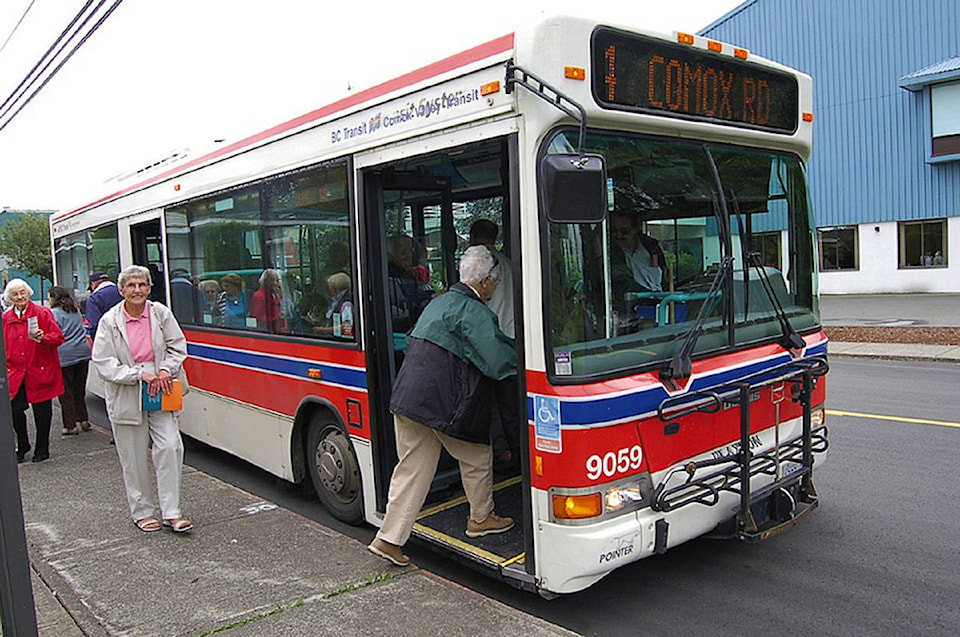Three Courtenay directors squared off over transit Tuesday at the Comox Valley Regional District board meeting.
City mayor Larry Jangula along with Counc. Manno Theos were at odds with Counc. Erik Eriksson over more spending next year to fund 4,000 extra hours of transit service.
“This is not a time when we can simply keep spending money,” said Jangula. “The taxpayers are tapped out.”
Jangula said funding for the “frequent transit” plan will cost taxpayers $700,000 over two years.
Theos said “we’ve talked recently about how it is so critical right now to basically get a hold of the reins of our budget.
“The taxpaying public of the Comox Valley is inundated with increases, they’re up above and beyond what they can afford.”
He said every household in Courtenay experienced a tax increase this year of from $350 to $700.
“That is not sustainable. With the transit, it’s absolutely not sustainable.”
Theos said the argument in favour of increased transit spending was “let’s do this because socially we’ll feel we’re not very nice” if it isn’t approved.
“Most communities I’m hearing from cannot afford increases, especially this kind of increase. My concerns are extremely heavy on this one,” he added.
Jangula said cutting the transit service elsewhere to cover the “frequent transit” plan might be acceptable.
He said the average senior wouldn’t use the service, preferring to get a friend, family member or a paid driving service to get them to their appointments.
“I caution the directors: This is going to be an election issue. I can guarantee that,” he said.
But Coun. Eriksson said the board had to decide on “whether we want a good transit system.”
“I’m a well-off taxpayer and I’m willing to share, with people who don’t have it as good as I do,” he said.
“The people who benefit from transit are people who don’t drive cars, and they still need to get somewhere,” Eriksson said.
He said it never ceases to amaze him that much larger expenditures pass without much discussion, while a relatively smaller amount - $400,000 extra for transit next year – is hotly debated.
“We’re willing to just roll over. Yet, are we courageous to say no to $400,000, but not $110 million,” he said referring to the projected cost for a new water filtration plant.
“Are we doing the right thing or the wrong thing. Transit serves a very useful purpose. I’m not afraid to put my voice of approval on this at all,” Eriksson said.
Comox director Counc. Barbara Price noted that for transit to be properly used, there has to be an efficient service that people can rely on.
“More people can actually choose to use transit and get out of their cars. I think transit is about the best bang for our buck,” she said.
“I think this is a real step in the right direction,” Price added of the “frequent transit” plan. “It’s been a slow growth and I think we’ll actually see a very healthy increase in ridership through doing this.”
Cumberland director Counc. Gwyn Sproule said right now the transit system isn’t working.
“There is no regular schedule, and if there is, that people can count on it. One thing to remember is that any of us could lose the ability to drive. A lot of people aren’t driving now because they’re elderly,” she said.
“I’m looking forward to increasing ridership by having a better schedule, and frequent transit corridors.”
Comox director Counc. Ken Grant and Area B director Rod Nichol sided with Theos and Jangula on the issue.
“I think it would be nice to have,” Grant said of the expanded transit service. “I’m not of the notion that people will automatically come.”
Now is not the time to pile on any more tax increases, he said.
“We should really be having a hard look at everything we do … and look at cutting back,” Grant added.
Nichol said the rural areas pay into transit, but receive little service.
“Taxpayers wonder why they’re paying into it. It’s just a no-go. I will not be supporting,” he said.
Area C director Edwin Grieve, though, supported the idea.
“We have to try it and see if it works,” he said. “We will see the results whether it’s going to be successful or not in due course.”
In the end, the “weighted vote” system saw the transit expenditure pass, 23 to 19.
The new “frequent transit” network will see 15-20 minute frequency between downtown Comox, North Island College, downtown Courtenay and the Driftwood Mall/Anfield Centre.
The new network would also bring a significant restructuring and improvement of other local routes.
